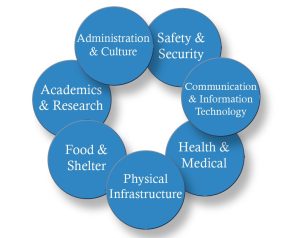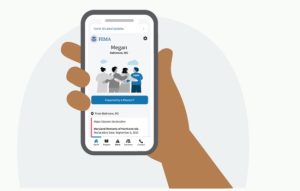In September’s newsletter we briefly discussed our commitment to national preparedness. As a part of that commitment, we are shifting our approach to Mission Continuity plans by applying FEMA’s Community Lifeline concept to campus.
FEMA’s Community Lifelines
Community Lifelines were first introduced by the Federal Emergency Management Agency (FEMA) to identify and prioritize the critical functions and services that must be maintained during and after a disaster. Community Lifelines serve as the foundation for the coordination of disaster response and recovery efforts for essential services such as transportation, food and water, energy, communications, healthcare, and public safety across the nation. Through the application of the Community Lifelines concept at the campus level, we are able to outline what services and functions are critical to our institution and develop more effective Mission Continuity plans.
Campus Lifelines
 Campus Lifelines refer to the essential services and infrastructure that support the continuity of the University. These lifelines are critical to preserving the University’s mission of teaching, research, and public service. Here is a glimpse into our Campus Lifelines:
Campus Lifelines refer to the essential services and infrastructure that support the continuity of the University. These lifelines are critical to preserving the University’s mission of teaching, research, and public service. Here is a glimpse into our Campus Lifelines:
- Safety and Security
- Ensures the safety and security of individuals, maintaining law and order, and protecting critical assets and systems that contribute to public safety.
- Food and Shelter
- Maintaining access to essential resources for students such as food, clean water, housing and related activities.
- Health and Medical
- Maintaining access to healthcare services for students and employees including medical treatment, counseling, and workplace safety.
- Administration and Culture
- Ensures the continuation of core administrative and cultural functions of the University to fulfill its educational mission and strategic objectives.
- Communication and Information Technology
- Ensure the continuation of communication, public information, and core technology infrastructure, such as 911 and emergency responder communications, alerts, warnings and messages.
- Physical Infrastructure
- Ensure the continuation of university provisions for transportation, utilities, and facility infrastructure, such as roadways, transit services, water, electricity, and buildings.
- Academics and Research
- Ensure the continuation of the university’s primary mission within academic and research functions, such as classroom instruction, student programming, and research activity.
In the upcoming stages of Mission Continuity program advancement, we will evaluate the critical operations of the University as well as the interrelated components that support our Campus Lifelines. In the meantime, please stay engaged with your plan management and explore the ways your plan supports Campus Lifelines. Additional information about the implementation of this concept and future plan development will be shared in the coming months.
Resources for Plan Administrators
The Plan Integration for Resilience Scorecard™ (PIRS™) method guides communities through the process of assessing and aligning their plans to maximize investments and reduce potential disaster impacts.



